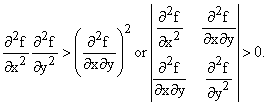The condition for a point r' to be critical for f is that all directional derivatives of f vanish at r = r'. This is the statement that
|
|
||
|
|
||
|
Suppose we have a function f (x, y) or f (x, y, z) defined in some domain,
and seek a global maximum for it, in that domain.We may do so as in ordinary
calculus, by finding critical points in the interior of our domain and comparing
behavior at them with that at its boundaries.
The condition for a point r' to be critical for f is that all directional
derivatives of f vanish at r = r'. This is the statement that
![]() f
is the zero vector, and all of its components vanish for (x, y, z) = (x', y',
z'):
f
is the zero vector, and all of its components vanish for (x, y, z) = (x', y',
z'):

Consider quadratics critical at the origin in two dimensions: they can behave like any of :
x2 + y2 which has a minimum there.
-2x2 - 3y2 which has a maximum there.
x2 - y2 which has a saddle point.
xy which has a saddle point.
10xy - x2- y2 which has a saddle point.
The coefficients of the quadratic that f resembles at r' are determined
by the second partial derivatives of f at r'. In order for the critical
point to be a minimum, the second partials with respect to x and y must
both be positive, and they must be large enough to dominate the xy term corresponding
to the cross partial ![]() .
.
The actual condition is the familiar discriminant, b2 -4ac,
of the quadratic must be negative, which means, in terms of derivatives, that
the square of the cross partial is less than the product of the other two:

In three dimensions a critical point will be a minimum when the "diagonal partials" are positive, the two dimensional condition holds for all pairs of variables (x, y), (x, z) and (y ,z), and the three dimensional determinant of the second partial derivatives is also positive.
We get a maximum when all diagonal second derivatives are negative, as is the three by three determinant of second partials, and the two by two determinants are all positive. (You can see this by changing the sign of f and applying the minimum conditions to -f. The two by two conditions are unaffected by the sign change.)